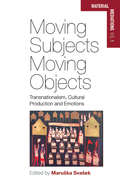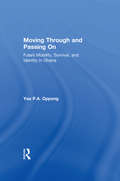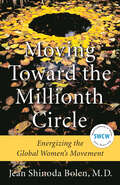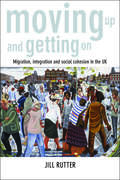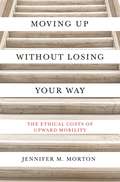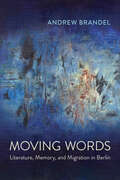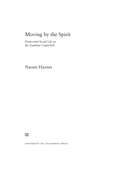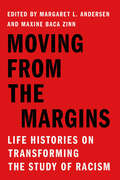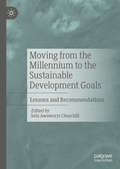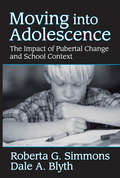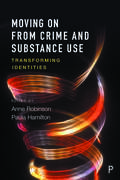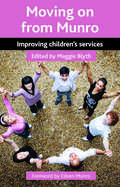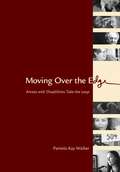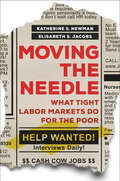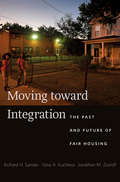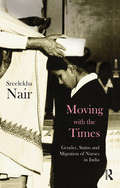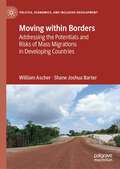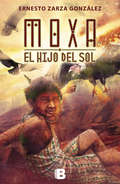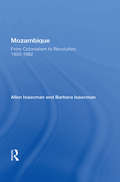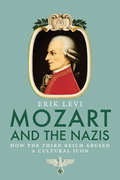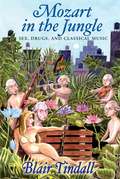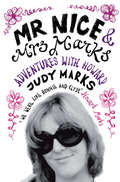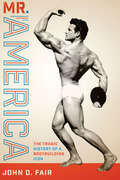- Table View
- List View
Moving Politics: Emotion and ACT UP's Fight Against AIDS
by Deborah B. GouldIn the late 1980s, after a decade spent engaged in more routine interest-group politics, thousands of lesbians and gay men responded to the AIDS crisis by defiantly and dramatically taking to the streets. But by the early 1990s, the organization they founded, ACT UP, was no more--even as the AIDS epidemic raged on. Weaving together interviews with activists, extensive research, and reflections on the author's time as a member of the organization, Moving Politics is the first book to chronicle the rise and fall of ACT UP, highlighting a key factor in its trajectory: emotion. Surprisingly overlooked by many scholars of social movements, emotion, Gould argues, plays a fundamental role in political activism. From anger to hope, pride to shame, and solidarity to despair, feelings played a significant part in ACT UP's provocative style of protest, which included raucous demonstrations, die-ins, and other kinds of street theater. Detailing the movement's public triumphs and private setbacks, Moving Politics is the definitive account of ACT UP's origin, development, and decline as well as a searching look at the role of emotion in contentious politics.
Moving Subjects, Moving Objects
by Maruška SvašekIn recent years an increasing number of scholars have incorporated a focus on emotions in their theories of material culture, transnationalism and globalization, and this book aims to contribute to this field of inquiry. It examines how 'emotions' can be theorized, and serves as a useful analytical tool for understanding the interrelated mobility of humans, objects and images. Ethnographically rich, and theoretically grounded case studies offer new perspectives on the relations between migration, material culture and emotions. While some chapters address the many different ways in which migrants and migrant artists express their emotions through objects and images in transnational contexts, other chapters focus on how particular works of art, everyday objects and artefacts can evoke feelings specific to particular migrant groups and communities. Case studies also analyse how artists, academics and policy makers can stimulate positive interaction between migrants and non-migrant communities.
Moving Through and Passing On: Fulani Mobility, Survival and Identity in Ghana
by Yaa P.A. Oppong"The Fulani are one of West Africa's most populous and geographically dispersed ethnic groups. Commonly thought of as a pastoral people, primarily engaged in cattle herding, Fulani peoples are in reality highly differentiated in livelihood and patterns of mobility. Despite having a long history of residence in Ghana, Fulani are considered ""aliens"" in the eyes of the state and ""strangers"" by the various ethnic groups among whom they reside. Among Fulani themselves, differences of place, circumstance, and experience have generated parallel ambigoities on matters of identity and survival. In Moving Through and Passing On, Yaa P.A. Oppong focuses on the Fulani of the Greater Accra region to offer the first detailed account of the lives of this transnational community in Ghana.Based on eighteen months of ethnographic fieldwork, Oppong develops detailed case studies and draws upon over two hundred in-depth life histories to explore issues of mobility, survival, and identity among this spacially dispersed and diverse group. Using perspectives and insights gained from oral life histories, private and public ceremonies, and ethnic associations, she examines the sites and circumstances in which people profess to be the ""same"" or ""different"" from one another. The markers of Fulani identity-as recognized by Fulani and non-Fulani alike-are examined. Oppong also explores the factors that allow them, as a distinct ethnic category, to maintain and perpetuate this identity and viability in Greater Accra. The metaphoric analogy of ""construction sites"" is employed to define the explicit and implicit events and recurring processes through which people conceive of themselves as Fulani. These locations and contexts of action include ethnic associations, public gatherings, and common rites of passage. The recurring processes include genealogical reckoning of kinship and endogamous marriage transactions, and the ways in which ties of descent and filiation are used to enha"
Moving Toward the Millionth Circle: Energizing the Global Women's Movement
by Jean Shinoda Bolen“Describes how every woman can be supported by a circle of friends with a sacred center, and how circles multiply their spiritual and political energy.” —Isabel AllendeWhile women’s individual experiences and stories differ, there remains to be a uniting factor that draws women from around the world together. In this book for women, author Jean Shinoda Bolen calls upon this uniting factor, this feminine spirit ingrained in the soul of each woman, as a source of motivation for activism. As a result, this activism focused on women empowerment is person-focused and heart-centered.Each of us wields the power to make change. By channeling our passions into all that we do, our voices and our actions, we take this world one step closer to being a better home for all who live in it. But joining with others is key to this effort. Bolen emphasizes the importance of relying on a support system, particularly women’s circles, in order to grow in influence.The metaphoric millionth circle is the tipping point into a post-patriarchal era. It is through the process of a growing number of people changing their perceptions and behaviors that a new era will begin. Those in the circles feed the activism by strengthening each other, and in turn, the movement as a whole. This spiritual book for women serves as a practical and poetic call to action, inspiring women and others to follow a path with soul.In Moving Toward the Millionth Circle you’ll discover . . .A deeper dive into The Millionth Circle InitiativeWords of passionate wisdom from an internationally known author and speakerA rallying cry for all women seeking change
Moving Up and Getting On: Migration, Integration and Social Cohesion in the UK
by Jill RutterIn most developed countries immigration policy is high on the political agenda. But what happens to migrants after their arrival – integration and social cohesion – has received less attention, yet these conditions matter to migrants and to wider society. Drawing on fieldwork in London and eastern England, Moving up and getting on is the first accessible, yet comprehensive, text to critique the effectiveness of recent integration and social cohesion policies and calls for a stronger political leadership. Written for those interested in public policy, the book argues that if the UK is to be successful in managing migration, there needs to be greater emphasis on the social aspects of integration and opportunities for meaningful social contact between migrants and longer-settled residents, particularly in the workplace.
Moving Up without Losing Your Way: The Ethical Costs of Upward Mobility
by Jennifer MortonThe ethical and emotional tolls paid by disadvantaged college students seeking upward mobility and what educators can do to help these students flourishUpward mobility through the path of higher education has been an article of faith for generations of working-class, low-income, and immigrant college students. While we know this path usually entails financial sacrifices and hard work, very little attention has been paid to the deep personal compromises such students have to make as they enter worlds vastly different from their own. Measuring the true cost of higher education for those from disadvantaged backgrounds, Moving Up without Losing Your Way looks at the ethical dilemmas of upward mobility—the broken ties with family and friends, the severed connections with former communities, and the loss of identity—faced by students as they strive to earn a successful place in society.Drawing upon philosophy, social science, personal stories, and interviews, Jennifer Morton reframes the college experience, factoring in not just educational and career opportunities but also essential relationships with family, friends, and community. Finding that student strivers tend to give up the latter for the former, negating their sense of self, Morton seeks to reverse this course. She urges educators to empower students with a new narrative of upward mobility—one that honestly situates ethical costs in historical, social, and economic contexts and that allows students to make informed decisions for themselves.A powerful work with practical implications, Moving Up without Losing Your Way paves a hopeful road so that students might achieve social mobility while retaining their best selves.
Moving Words: Literature, Memory, and Migration in Berlin (Anthropological Horizons)
by Andrew BrandelIn the decades since the fall of the Berlin Wall, Berlin has re-emerged as a global city in large part thanks to its reputation as a literary city – a place where artists from around the world gather and can make a life. Moving Words foregrounds the many contexts in which life in the city of Berlin is made literary – from old neighbourhood bookshops to new reading circles, NGOs working to secure asylum for writers living in exile to specialized workshops for young migrant poets. Highlighting the differences, tensions, and contradictions of these scenes, this book reveals how literature can be both a site of domination and a resource for resisting and transforming those conditions. By attending to the everyday lives of writers, readers, booksellers, and translators, it offers a crucial new vantage point on the politics of difference in contemporary Europe, at a moment marked by historical violence, resurgent nationalism, and the fraught politics of migration. Rooted in ethnographic fieldwork, rich historical archives, and literary analysis, Moving Words examines the different claims people make on and for literature as it carries them through the city on irregular and intersecting paths. Along the way, Brandel offers a new approach to the ethnography of literature that aims to think anthropologically about crossings in time and in space, where literature provides a footing in a world constituted by a multiplicity of real possibilities.
Moving Working Families Forward: Third Way Policies That Can Work
by Robert Cherry“Cherry and Lerman have written a compelling book that challenges the orthodoxies of both the political ‘left’ and ‘right’, and that promotes a set of policies to improve the economic status of lower-to-middle income working families. All who care about the well-being of working families will learn a great deal from their analysis.”—Harry Holzer, Professor of Public Policy, Georgetown University “Offers highly sophisticated proposals for helping working families advance in the wake of welfare reform. Cherry and Lerman are very expert, and they write very well.”—Lawrence M. Mead, Professor of Politics and Public Policy, New York University Even as our political system remains deeply divided between right and left, there is a clear yearning for a more moderate third way that navigates an intermediate position to address the most pressing issues facing the United States today. Moving Working Families Forward points to a Third Way between liberals and conservatives, combining a commitment to government expenditures that enhance the incomes of working families while recognizing that concerns for program effectiveness, individual responsibility, and underutilization of market incentives are justified. Robert Cherry and Robert Lerman provide the context to understand the distinctive qualities of Third Way policies, focusing on seven areas that substantially affect working families: immigration, race and gender earnings disparities, education, housing, strengthening partnerships, and federal taxes. Balancing empirical studies with voices of working class people, they offer an important perspective on how public policies should be changed. A timely approach, Moving Working Families Forward makes policy recommendations that are both practical and transformative.
Moving by the Spirit: Pentecostal Social Life on the Zambian Copperbelt
by Naomi HaynesDrawing on two years of ethnographic research, Naomi Haynes explores Pentecostal Christianity in the kind of community where it often flourishes: a densely populated neighborhood in the heart of an extraction economy. On the Zambian Copperbelt, Pentecostal adherence embeds believers in relationships that help them to “move” and progress in life. These efforts give Copperbelt Pentecostalism its particular local character, shaping ritual practice, gender dynamics, and church economics. Focusing on the promises and problems that Pentecostalism presents, Moving by the Spirit highlights this religion’s role in making life possible in structurally adjusted Africa.
Moving from the Margins: Life Histories on Transforming the Study of Racism (Stanford Studies in Comparative Race and Ethnicity)
by Margaret L. Andersen and Maxine Baca ZinnAt a time when movements for racial justice are front and center in U.S. national politics, this book provides essential new understanding to the study of race, its influence on people's lives, and what we can do to address the persistent and foundational American problem of systemic racism. Knowledge about race and racism changes as social and historical conditions evolve, as different generations of scholars experience unique societal conditions, and as new voices from those who have previously been kept at the margins have challenged us to reconceive our thinking about race and ethnicity. In this collection of essays by prominent sociologists whose work has transformed the understanding of race and ethnicity, each reflects on their career and how their personal experiences have shaped their contribution to understanding racism, both in scholarly and public debate. Merging biography, memoir, and sociohistorical analysis, these essays provide vital insight into the influence of race on people's perspectives and opportunities both inside and outside of academia, and how racial inequality is felt, experienced, and confronted.
Moving from the Millennium to the Sustainable Development Goals: Lessons and Recommendations
by Sefa Awaworyi ChurchillThis book presents a collection of chapters that examine various dimensions of development. Between 2000 and 2015, the Millennium Development Goals (MDGs) remained the overarching development framework that governed the international development community. After a decade and half of commitment to the MDGs, the framework is widely considered a success, although progress reported across countries has been uneven. The new overarching international development framework may not be successful or present the best opportunities for the desired global change without a better understanding of factors that contributed the most or the least to the attainment of the MDGs. The chapters presented in this book provide discussions and insights into understanding these factors better. They represent a collection of scholarship that address some of the important questions in international development. They adopt a wide range of research methods to provide insight into what works, and what does not, in promoting the stipulated development goals.
Moving into Adolescence: The Impact of Pubertal Change and School Context (Social Institutions And Social Change Ser.)
by Roberta G. Simmons Dale A. BlythFrom the sociological point of view, adolescence traditionally has been described as a period of physical maturity and social immaturity. Adolescents reach physical adulthood before they are capable of functioning well in adult social roles. The disjunction between physical capabilities and socially allowed independence and power and the concurrent status ambiguities are viewed as stressful for the adolescent in modern Western society. It has been assumed that the need to disengage from parents during these years will result in high levels of rebellion and parent-child conflict. Moving into Adolescence follows students as they make a major life course transition from childhood into early adolescence.Substantial controversy has been generated within the behavioral sciences concerning the difficulty of adolescence as a transitional period. On the one hand, there are those who characterize the period as an exceptionally and necessarily stressful time in the life course. On the other hand, many investigators treat this view of adolescence as their straw man. To them, the supposed tumult of adolescence is just that--supposed and mythical. The purpose of this book is to study the transition from childhood into early and middle adolescence in order to investigate change along a wide variety of psychosocial dimensions with a particular focus on the self-image.The authors investigate the impact of timing of pubertal change and also the movement from an intimate, elementary school context into a large-scale secondary school environment. The first major movement into a large-scale organizational context may cause difficulty for the child, as may the dramatic changes of puberty. In addition, gender differences and changes in gender differences are studied. Both short- and long-term consequences of transition are examined focusing on is the role of pubertal change and school transition.
Moving on From Crime and Substance Use: Transforming Identities
by Anne Robinson and Paula HamiltonDesistance is one of the big news stories of the criminological world. Research suggests that, as ‘offenders’ turn their backs on crime, they often change their identities as well as their behaviour. Yet we know much less about how reforming or transforming identity might be affected by gender, age or ethnicity. This book focuses on diversity and showcases research from a wide range of authors in the field. It considers the similarities and differences between desisting from crime and recovering from addiction. Taking the desistance and recovery debates in unfamiliar directions, it examines the experiences of change for individuals seeking healthier and more successful futures.
Moving on from Munro: Improving Children's Services
by Maggie BlythFour years after the publication of the influential Munro Report (2011) this important publication draws together a range of experts working in the field of child protection to critically examine what impact the reforms have had on multi-agency child protection systems in this country, at both local and national level. With a particular emphasis on early intervention, vulnerable adolescents and effective multi-agency responses to young people at risk, specialists from policy and practice alongside academics in different areas of children’s services consider progress in improving child protection arrangements, in transforming services and the challenges that remain. Local Safeguarding Children Boards (LSCBs), the statutory bodies responsible for local scrutiny of child protection arrangements, are now subject to Ofsted inspection and this publication considers the role of LSCBs, how services should respond to the most vulnerable children and what 'good' services look like.
Moving over the Edge: Artists with Disabilities Take the Leap
by Pamela K. WalkerA book about the author's coming of age alongside disability activists and artists with disabilities, reflecting the sociological evolution from disability rights to disability culture. It features many of the artists and groups that emerged in the San Francisco Bay Area in the late 1980s, including Axis Dance Company, Bruce Curtis, CJ Jones, David Roche, Cheryl Marie Wade and Wry Crips Disabled Women's Theater.
Moving the Needle: What Tight Labor Markets Do for the Poor
by Katherine S. Newman Elisabeth S JacobsThis timely investigation reveals how sustained tight labor markets improve the job prospects and life chances of America’s most vulnerable households Most research on poverty focuses on the damage caused by persistent unemployment. But what happens when jobs are plentiful and workers are hard to come by? Moving the Needle examines how very low unemployment boosts wages at the bottom, improves benefits, lengthens job ladders, and pulls the unemployed into a booming job market. Drawing on over seventy years of quantitative data, as well as interviews with employers, jobseekers, and longtime residents of poor neighborhoods, Katherine S. Newman and Elisabeth S. Jacobs investigate the most durable positive consequences of tight labor markets. They also consider the downside of overheated economies that can ignite surging rents and spur outmigration. Moving the Needle is an urgent and original call to implement policies that will maintain the current momentum and prepare for potential slowdowns that may lie ahead
Moving toward Integration: The Past and Future of Fair Housing
by Richard H. SanderReducing residential segregation is the best way to reduce racial inequality in the United States. African American employment rates, earnings, test scores, even longevity all improve sharply as residential integration increases. Yet far too many participants in our policy and political conversations have come to believe that the battle to integrate America’s cities cannot be won. Richard Sander, Yana Kucheva, and Jonathan Zasloff write that the pessimism surrounding desegregation in housing arises from an inadequate understanding of how segregation has evolved and how policy interventions have already set many metropolitan areas on the path to integration. Scholars have debated for decades whether America’s fair housing laws are effective. Moving toward Integration provides the most definitive account to date of how those laws were shaped and implemented and why they had a much larger impact in some parts of the country than others. It uses fresh evidence and better analytic tools to show when factors like exclusionary zoning and income differences between blacks and whites pose substantial obstacles to broad integration, and when they do not. Through its interdisciplinary approach and use of rich new data sources, Moving toward Integration offers the first comprehensive analysis of American housing segregation. It explains why racial segregation has been resilient even in an increasingly diverse and tolerant society, and it demonstrates how public policy can align with demographic trends to achieve broad housing integration within a generation.
Moving with the Times: Gender, Status and Migration of Nurses in India
by Sreelekha NairThis book is an attempt to penetrate the silence that surrounds the lives of nurses as migrant women. It offers a perceptive understanding of the trials faced specifically by women from the state of Kerala, in their personal and professional spheres, in the challenges posed to single women migrants as such, and the lower status ascribed to the job. In highlighting aspects of their lived experiences, it reveals how the identities of gender, class and ethnicity unmask the realities behind claims of egalitarianism and equal citizenship. Nurses from Kerala form one of the largest groups of migrant women workers in the international service sector along with Filipinos and Sri Lankans. Comparatively better salaries, work opportunities and financial independence, along with a desire to travel across the world, are often the reasons behind these migrations. For many of these women, the professional choice of nursing is usually the first step towards migration, while finding employment in Delhi, the urban capital of India, is intended as a transition point before they migrate abroad, a trajectory which may remain unrealised. In focusing on nurses who choose to work in Delhi, the author recounts how the patriarchy of the original place is recreated and relived in destination cities. In as much as traditional stigmatisation of nursing (as a ‘dirty’ profession), deeply entrenched gender prejudices, and status and role anxieties act as deterrents, these women remain undaunted in the face of adversities and treat their exposure to, and experience of, technology and nursing care in the bigger hospitals in Delhi as part of the training that is required to apply abroad. Through extensive empirical research, case studies and personal interviews, Moving with the Times illustrates nurses’ lives in Delhi, providing an account of the dynamics — between traditional patriarchy, norms and associated identities, low professional status and marginality coupled at once with the sense of personal freedom, a new career and space — that migration compels these women to negotiate. This book will appeal to scholars of sociology, gender and women’s studies, nursing and healthcare, and those interested in migration and identities.
Moving within Borders: Addressing the Potentials and Risks of Mass Migrations in Developing Countries (Politics, Economics, and Inclusive Development)
by William Ascher Shane Joshua BarterThis book highlights the attention that policymakers, activists, and the public should pay to internal migration. Although prominent research has analyzed particular types of internal migration, especially urbanization and internally displaced persons (IDPs), the narrow scope of existing studies cannot capture the overlaps of motivation and circumstances that pose serious policy dilemmas. The book is distinctive in examining the full range of modes and motives of internal migration: state-sponsored or unsponsored, coerced or voluntary, land-seeking or market-seeking, urban or rural, and so on. While approaching internal migration holistically, it also emphasizes how it is distinct from international migrations, especially the central role of the state, whose internal divisions and defensive reactions to challenges often play decisive roles in governing migration. The writing style is geared towards accessibility, making it appropriate for college- and graduate-level students as well as the broader public.
Moxa el hijo del sol
by Ernesto Zarza GonzalezUna aventura maravillosa por las culturas precolombinas. Moxa, el Hijo del Sol, es un viaje fantástico por el mundo de los Muiscas, una de las principales civilizaciones precolombinas de la América del Sur Septentrional. Una épica sobre nuestros antepasados que poblaron gran parte de lo que hoy es Colombia. Su autor, Ernesto Zarza González, nos sorprende con esta novela que relata las vivencias, obsesiones y mitos de esta etnia indígena. Una novedad editorial que desentraña parte de la riqueza cultural de la cual somos legítimos herederos.
Mozambique: From Colonialism To Revolution, 1900-1982 (Ohio Short Histories Of Africa Ser.)
by Barbara Isaacman Allen IsaacmanDrawing on oral interviews as well as written primary sources, the authors of this book focus on the changing and complex Mozambican reality. They focus their study on the changing and complex Mozambican reality to avoid depicting the colonized people as passive victims. .
Mozart and the Nazis: How the Third Reich Abused a Cultural Icon
by Erik LeviA music historian uncovers Nazi Germany&’s use of Mozart as a WWII propaganda tool in this &“intriguing study [that] comprehends a range of vital topics&” (Choice). As the Nazi war machine expanded its bloody ambitions across Europe, the Third Reich sought to promote a sophisticated and even humanitarian image of German culture through the tireless promotion of Mozart&’s music. In this revelatory book, Erik Levi draws on World War II era articles, diaries, speeches, and other archival materials to provide a new understanding of how the Nazis shamelessly manipulated Mozart for their own political advantage. Mozart and the Nazis also explores the continued Jewish veneration of the composer during this period while also highlighting some of the disturbing legacies that resulted from the Nazi appropriation of his work. Enhanced by rare contemporary illustrations, Mozart and the Nazis is a fascinating addition to the study of music history, World War II propaganda, and twentieth century politics.
Mozart in the Jungle: Sex, Drugs and Classical Music
by Blair TindallA candid and unsparing account of orchestral life
Mr Nice & Mrs Marks: - Adventures with Howard
by Judy Marks'I have long wanted to write a book about my life and the extraordinary years I spent with my husband Howard Marks. I feel now is the time. I want to write it from a woman's perspective and describe what it was like to be married to such a charismatic drug smuggler.' Judy MarksHoward Marks's story has passed into hippie folklore. At one time, the world's then most wanted man had 43 aliases, 89 phone lines and 25 registered companies. Thanks to the technical brilliance of his networking skills, it was estimated that he was trafficking as much as a tenth of all the marijuana smoked in the world. But this is only half the story. Intimately involved throughout was Marks's wife Judy. From living the high life hobnobbing with movie stars and euro trash to mixing it with the IRA and CIA, then the long, increasingly desperate years on the run, Mr Nice and Mrs Marks is about the exhilaration of their criminal life and the hell of not knowing what's happening when your husband stops telling you the truth. Now, for the first time, Judy tells her own side of the tale.
Mr. America: The Tragic History of a Bodybuilding Icon (Terry and Jan Todd Series on Physical Culture and Sports)
by John D. Fair&“Map[s] the shifting definitions of gender and masculinity . . . provides the rare insight into the world of bodybuilding that only an insider could offer.&” —Sport in American History For most of the twentieth century, the &“Mr. America&” image epitomized muscular manhood. From humble beginnings in 1939 at a small gym in Schenectady, New York, the Mr. America Contest became the world&’s premier bodybuilding event over the next thirty years. Rooted in ancient Greek virtues of health, fitness, beauty, and athleticism, it showcased some of the finest specimens of American masculinity. Interviewing nearly one hundred major figures in the physical culture movement (including twenty-five Mr. Americas) and incorporating copious printed and manuscript sources, John D. Fair has created the definitive study of this iconic phenomenon. Revealing the ways in which the contest provided a model of functional and fit manhood, Mr. America captures the event&’s path to idealism and its slow descent into obscurity. As the 1960s marked a turbulent transition in American society—from the civil rights movement to the rise of feminism and increasing acceptance of homosexuality—Mr. America changed as well. Exploring the influence of other bodily displays, such as the Mr. Universe and Mr. Olympia contests and the Miss America Pageant, Fair focuses on commercialism, size obsession, and drugs that corrupted the competition&’s original intent. Accessible and engaging, Mr. America is a compelling portrayal of the glory days of American muscle. &“An entertaining narrative of the bodybuilding subculture in America.&” —Kirkus Reviews &“Deftly written and superbly researched.&” —Journal of Sport History

